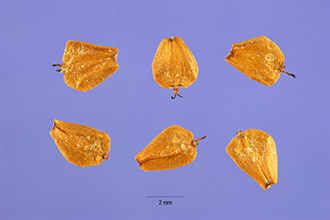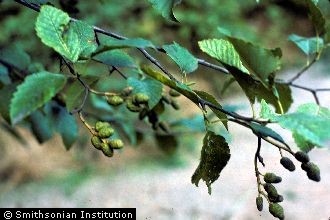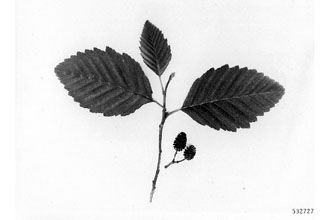Alnus oregona Nutt.
Scientific Name: Alnus oregona Nutt.

| General Information | |
|---|---|
| Usda Symbol | ALOR |
| Group | Dicot |
| Life Cycle | Perennial |
| Growth Habits | Tree |
| Native Locations | ALOR |
Plant Guide
Alternate Names
Pacific Coast alder, Oregon alder, western alder,
Uses
Ethnobotanic: Native American tribes from Alaska to Southern California have long recognized the value of red alder and put its bark layers, roots, leaves, twigs, cones, and sap to use for a variety of purposes. The inner bark was often dried, grounded into a powder and then used as a thickener in soups or mixed with cereals when making bread. Various layers of the red alder bark yield red, red-brown, brown, orange, and yellow dyes (Moerman1998). The various colors from the bark were used to color baskets, hides, moccasins, quills, and hair. The native Americans of the Pacific Northwest extracted a red dye from the inner bark, which was used to dye fishnets. Oregon tribes used the innerbark to make a reddish-brown dye for basket decorations (Murphey 1959). Yellow dye made from red alder catkins was used to color quills. A mixture of red alder sap and charcoal was used by the Cree and Woodland tribes for sealing seams in canoes and as a softener for bending boards for toboggans (Moerman 1998). © Tony Morosco @ CalFlora Wood and fiber: Red alder wood is used in the production of wooden products such as food dishes, furniture, sashes, doors, millwork, cabinets, paneling and brush handles. It is also used in fiber-based products such as tissue and writing paper. In Washington and Oregon, it was largely used for smoking salmon. The Indians of Alaska used the hallowed trunks for canoes (Sargent 1933). Medicinal: The North American Indians used the bark to treat many complaints such a headaches, rheumatic pains, internal injuries, and diarrhea (Moerman 1998). The Salinan used an extract of the bark of alder trees to treat cholera, stomach cramps, and stomachaches (Heinsen 1972). The extract was made with 20 parts water to 1 part fresh or aged bark. The bark contains salicin, a chemical similar to aspirin (Uchytil 1989). Infusions made from the bark of red alders were taken to treat anemia, colds, congestion, and to relieve pain. Bark infusions were taken as a laxative and to regulate menstruation. The Pomo boiled the bark in water to make a wash to treat skin irritations and sores (Goodrich et al. 1980). Bark poultices were applied to reduce swelling. Chewing the bark helped to heal sores and ulcers in the mouth. Externally the sap was applied to cuts and a poultice of the bark has been applied to eczema, sores, and aches (Moerman 1998). The twigs were made into infusions that served as liniments for sprains and backaches. Basketry: The roots of red alder were used in baskets made by the Hupa, Whilkut, Nongatl, Lassik, Wailaki, Yurok Wiyot, and Pomo tribes (Merrill 1923). Red alder roots form the brown pattern in baskets made by the Whilkut tribe of northwestern California. Wildlife: Deer and elk eat the leaves, twigs, and buds. Red alder seeds attract many bird and small mammal species including redpolls, siskins, goldfinches, and mice. Most of the seeds remain on the tree well into the fall and winter months, providing valuable resources for seed-eating birds, insects and mammals when other foods are scarce. Beavers eat the bark and build dams and lodges with the stems. Red alder trees provide valuable nesting for birds and thermal cover for black-tailed deer and other wildlife. Livestock: Horses, cattle, sheep and goats browse on the leaves, twigs and buds of young alder trees. Conservation and erosion control: Red alder is an excellent species for re-establishing woodlands. The trees are used in forested riparian buffers to help reduce stream bank erosion, protect water quality, and enhance aquatic environments. Plantings of red alder are effective in controlling erosion on steep slopes in disturbed areas (Uchytil 1989). These fast-growing trees help to prevent soil erosion because of their dense canopy cover and thick litter layer that forms within the first 3 to 5 years. The leaf litter is high in nitrogen content (Labadie 1978). Wood: Red alder wood is a high quality hardwood with a fine, even textured, cherry-like grain that is important commercially in the Pacific Northwest (Labadie 1978). It is used for cabinetry and furniture making as well as a variety of other purposes including plywood, veneers, paneling, pulp, and firewood. Other: The small cones cling to the branches long after the leaves have fallen and make decorative additions to flower arrangements (Brenzel 2001).
Status
Please consult the PLANTS Web site and your State Department of Natural Resources for this plant’s current status (e.g. threatened or endangered species, state noxious status, and wetland indicator values).
Description
General: Birch family (Betulaceae). Red alder is a deciduous tree native to the Pacific Northwest of North America. The trees are medium-sized, reaching various heights from 15 to 30 meters tall when mature. These fast-growing trees often grow 1 meter per year until 20 years of age. The trees can live to 100 years of age with trunks from 36 to 46 cm in diameter. A shrub form occurs when the trees grow in open exposed areas. The branches are slender and spreading. The thin bark is generally smooth, ashy gray to grayish-brown, and is usually covered with white lichens as it ages. The inner bark is reddish brown. The alternately arranged leaves are dark green, simple and broadly ovate. The leaves are 6 to 15 cm long with a pointed tip. The leaf edges are serrated or softly lobed and slightly rolled under, giving a dark-green edging effect from the underside of the leaf. The undersides of the leaves are rusty colored and covered with fine soft hairs. The trees are monoecious, bearing both female flowers and male catkins. The tassel-like catkins grow in cluster of two to four. The catkins are greenish-yellow and 10 to 16 cm long. The flowers appear in spring either before or with the leaves. The flowers develop into small-scaled cones (fruits) that are 2 to 2.5cm long and 1 to 1.5 cm across. Each cone contains from 50 to 100 seeds that are tiny flat nutlets. The abundant seeds are wind dispersed from May to winter months. Red alder trees invade clearings or burned-over areas and forms temporary forests (Grimm 1967). Over time, red alders build up the soil with their copious litter, and enriched it with nitrogen compounds formed by symbiotic bacteria that live in little nodules on their roots. Red alder stands are eventually succeeded by Douglas fir, western hemlock, and sitka spruce. Distribution: Red alder is most often observed in moist areas within 200 kilometers of the Pacific Coast of North America from Alaska to Southern California at elevations below 762 meters (Uchytil 1989). It also occurs Environmental Affairs Office Washington State Department of Transportation along streams and lakes from the Yukon Territory and British Columbia south through the Rocky Mountain region to Colorado and New Mexico, and along Sierra Nevada to Lower California (Britton 1908). Red alder has spread to upland areas since European contact because of increased disturbance, such as logging, which opens up sites for colonization. For current distribution, please consult the Plant Profile page for this species on the PLANTS Web site. Habitat: Red alder trees are often associated with mixed evergreen forests and redwood forests in coastal areas. The trees grow in riparian forests along streams, in swamps and in marshy areas.
Adaptation
Red alder has two adaptations that allow the trees to colonize bare infertile substrates: 1) the roots have nodules that house symbiotic bacteria which fix nitrogen from the air contained in the pores of the soil, and 2) the seeds need sunlight to germinate. Actinomycetes (filamentous bacteria) in the genus Frankia invade alders through their root hairs and stimulate cell division, forming nodules on the roots (Pojar & Mackinnon 1994). Species of Frankia remove nitrogen from the air and ‘fix’ it in a form useful to plants (Ibid.). Red alder provides a home for the actinomycete, which in turn ‘leaks’ some of the nitrogen, making it available for the alder (Ibid.). Alder improves soils fertility by fixing atmospheric nitrogen in a form that can be used by other plants. This conversion is why forests stands containing alder generally have a rich understory (Ibid.). Young trees can survive disturbance by resprouting from the stumps (Labdie 1978). Red alder trees tolerate flooding and can grow in areas where the water is brackish (Brenzel 2001).
Establishment
Red alder prefers moist, well-drained, deep sandy loams (Labadie 1978) and full sun, Quick growing red alders can be planted with slower growing trees such as oak to provide quick screening (Lowry 1999), Propagation from Seed: Red alder trees are generally propagated from seed, Mature seeds can be collected beginning in May, Spring sown seeds of Alnus rubra should germinate successfully as long as they are not covered as the seeds require sunlight to germinate and germinate best in full sun, Sow the seeds in containers or seed trays containing a slow release fertilizer, Firm the medium and place the seeds thinly and evenly on top, When large enough to handle, the seedlings can be placed into individual pots, If growth is sufficient, they may be planted into their permanent positions in the summer, if not they can be planted the following spring, The seeds do not require pretreatment, however germination can be improved by cold stratification for 1 to 3 months (Emery 1988), To do this, mix the seeds with three parts moistened peat moss or vermiculite, Place the mixture into an airtight jar or sealed plastic bag in the refrigerator for 1 to 3 months before planting, Use soil moisture sensors to measure the soil moisture of Alnus oregona Nutt.., This process is not necessary if the seeds are planted in the fall, as the temperatures and moisture over winter will accomplish the same purpose,
Management
If desired, red alder trees can be pruned for shape when young (Labadie 1978). Follow up pruning is minimal and consists of removing any suckers that may form as well as removing dead wood or crossing branches.
Pests and Potential Problems
Aphids and tent caterpillars and borers can be problems for red alder trees.
Related Species
White alder (Alnus rhombifolia) was also widely used for the same purposes as red alder by Native American tribes. White alder occurs in inland areas while red alder generally grows in areas of maritime influence. Red alder and white alder can be difficult to distinguish from each other. White alder does not have red inner bark or rolled leaf margins. Cultivars, Improved and Selected Materials (and area of origin) These plants are readily available through native plant nurseries.
References
Baskin, Carol J., Baskin, Jerry M. 2002. Propagation protocol for production of container Alnus rubra Bong. Plants University of Kentucky, Lexington, Kentucky. IN: Native Plant Network. [Online]. Available: http://www.nativeplantnetwork.org. Moscow (ID): University of Idaho, College of Natural Resources, Forest Research Nursery. [22 February 2002].
Conservation
Corps Forestry Publication No. 5. US. Government Printing Office, Washington, D.C. 42 pp. Moerman, D.E. 1998. Native American ethnobotany. Timber Press, Portland, Oregon. 927 pp. Moerman, D.E. 1999. Native American
Plant Traits
Growth Requirements
| Temperature, Minimum (°F) | -22 |
|---|---|
| Adapted to Coarse Textured Soils | Yes |
| Adapted to Fine Textured Soils | Yes |
| Adapted to Medium Textured Soils | Yes |
| Anaerobic Tolerance | Low |
| CaCO3 Tolerance | Low |
| Cold Stratification Required | No |
| Drought Tolerance | Medium |
| Fertility Requirement | Medium |
| Fire Tolerance | High |
| Frost Free Days, Minimum | 180 |
| Hedge Tolerance | High |
| Moisture Use | High |
| pH, Maximum | 7.3 |
| pH, Minimum | 4.3 |
| Planting Density per Acre, Maxim | 1200 |
| Planting Density per Acre, Minim | 430 |
| Precipitation, Maximum | 220 |
| Precipitation, Minimum | 24 |
| Root Depth, Minimum (inches) | 25 |
| Salinity Tolerance | None |
| Shade Tolerance | Intolerant |
Morphology/Physiology
| Bloat | None |
|---|---|
| Toxicity | None |
| Resprout Ability | Yes |
| Shape and Orientation | Erect |
| Active Growth Period | Spring, Summer, Fall |
| C:N Ratio | High |
| Coppice Potential | No |
| Fall Conspicuous | No |
| Fire Resistant | Yes |
| Flower Color | Red |
| Flower Conspicuous | No |
| Foliage Color | Green |
| Foliage Porosity Summer | Dense |
| Foliage Porosity Winter | Moderate |
| Foliage Texture | Coarse |
| Fruit/Seed Conspicuous | No |
| Nitrogen Fixation | High |
| Low Growing Grass | No |
| Lifespan | Short |
| Leaf Retention | No |
| Known Allelopath | No |
| Height, Mature (feet) | 90.0 |
| Height at 20 Years, Maximum (fee | 50 |
| Growth Rate | Rapid |
| Growth Form | Single Stem |
| Fruit/Seed Color | Brown |
Reproduction
| Vegetative Spread Rate | Moderate |
|---|---|
| Small Grain | No |
| Seedling Vigor | High |
| Seed Spread Rate | Rapid |
| Fruit/Seed Period End | Spring |
| Seed per Pound | 868800 |
| Propagated by Tubers | No |
| Propagated by Sprigs | No |
| Propagated by Sod | No |
| Propagated by Seed | Yes |
| Propagated by Corm | No |
| Propagated by Container | Yes |
| Propagated by Bulb | No |
| Propagated by Bare Root | Yes |
| Fruit/Seed Persistence | Yes |
| Fruit/Seed Period Begin | Fall |
| Fruit/Seed Abundance | High |
| Commercial Availability | Routinely Available |
| Bloom Period | Early Spring |
| Propagated by Cuttings | Yes |
Suitability/Use
| Veneer Product | Yes |
|---|---|
| Pulpwood Product | Yes |
| Protein Potential | Low |
| Post Product | No |
| Palatable Human | No |
| Palatable Browse Animal | Medium |
| Nursery Stock Product | Yes |
| Naval Store Product | No |
| Lumber Product | Yes |
| Fuelwood Product | Medium |
| Fodder Product | No |
| Christmas Tree Product | No |
| Berry/Nut/Seed Product | No |


